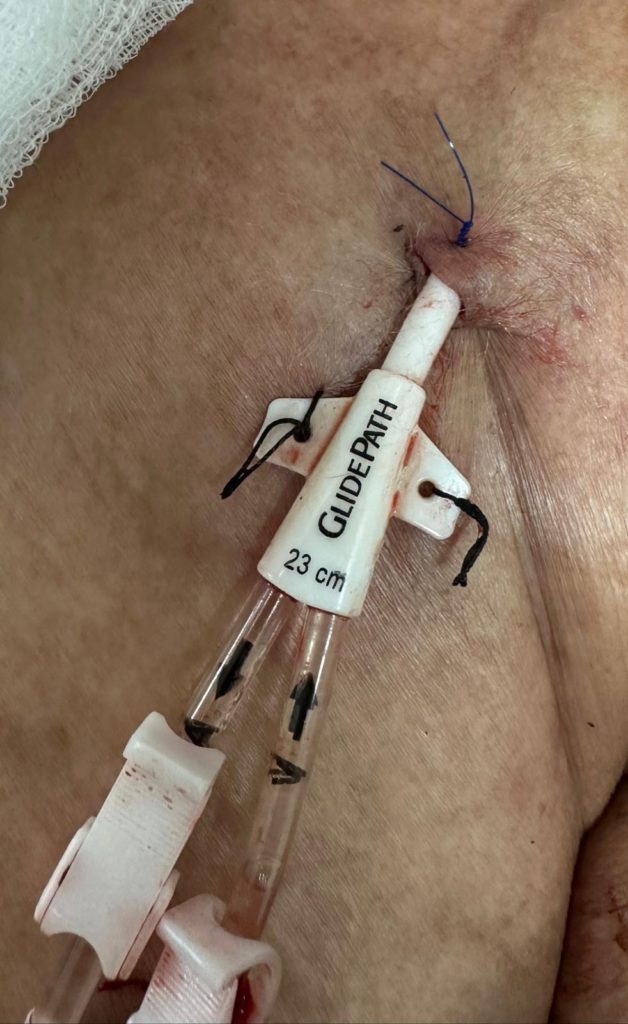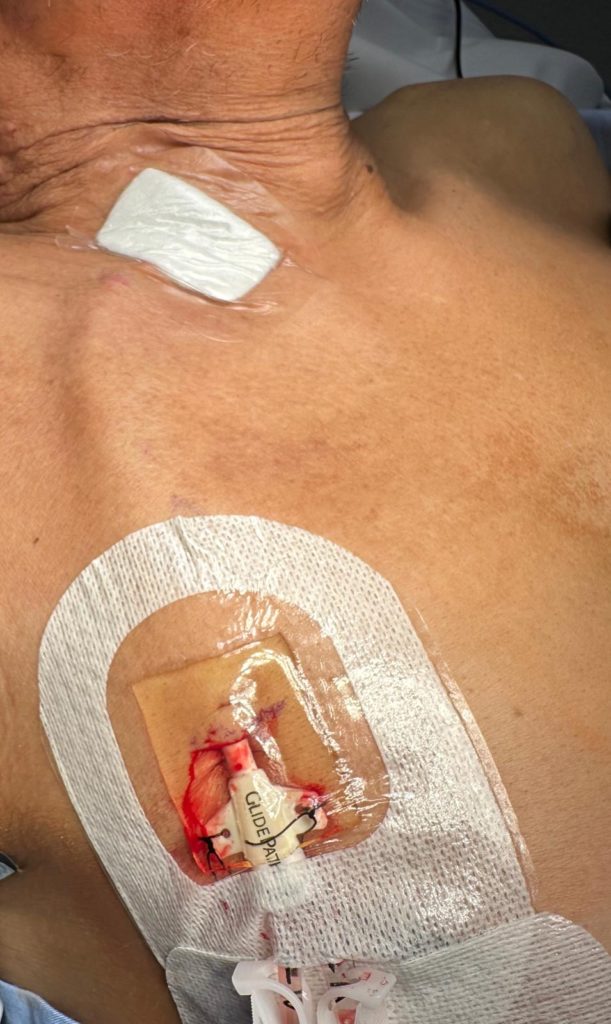A permanent tunnelled dialysis catheter, also known as a tunnelled central venous catheter (TCVC) is a medical device used for long-term dialysis treatment in patients with chronic kidney disease. It is inserted into a large vein, usually in the neck or chest, and allows for the removal and return of blood during dialysis. The catheter is designed with a tunnel that runs under the skin, which helps to secure it in place and reduce the risk of infection. This type of catheter is intended for extended use, typically lasting several months to years, providing a reliable access point for dialysis treatments. It can be used immediately after it is inserted.
WHO performs this procedure and how is it exactly done?
The insertion of a permanent tunnelled dialysis catheter is typically performed by a vascular specialist. This can usually be performed with the patient awake under local anaesthetic and sedation. The procedure approximately takes 15 minutes. Here is a general overview of the insertion procedure:
- Preparation: The patient is positioned and prepped for the procedure. This may involve cleaning and sterilizing the insertion site.
- Local anaesthesia: The area where the catheter will be inserted is numbed with a local anaesthetic to minimize discomfort.
- Incision: A small incision is made in the skin at the chosen insertion site, usually in the neck or chest.
- Tunnel creation: Using a tunnelling technique, a subcutaneous tunnel is created from the incision site to a separate exit site nearby. This tunnel helps secure the catheter and reduces the risk of infection.
- Catheter placement: The catheter is carefully inserted into a large vein, such as the jugular or subclavian vein under ultrasound guidance and threaded through the tunnel to the exit site.
- Catheter fixation: Once properly positioned, the catheter is secured in place using sutures or a special anchoring device.
- X-ray confirmation: A chest X-ray or fluoroscopy is often performed to confirm the correct placement of the catheter and ensure it is functioning properly.
- Dressing and care: The insertion site is dressed with sterile dressings, and the patient is provided with instructions for care and maintenance of the catheter.
It’s important to note that the specific procedure may vary depending on individual circumstances and the preferences of the healthcare provider.
What are the benefits and risks of a TCVC?
A permanent tunnelled dialysis catheter can offer certain benefits and also present potential risks. Here are some key points to consider:

Benefits:
- Immediate access: A TCVC allows for immediate access to the bloodstream for dialysis treatment, making it a suitable option for patients who require urgent or temporary dialysis access.
- Convenience: Unlike other types of dialysis accesses, such as arteriovenous fistulas or grafts, a TCVC does not require surgery and can be inserted relatively quickly. This can be beneficial for patients who are unable to undergo surgery or have limited vascular access options.

Risks:
- Infection: One of the main risks associated with TCVCs is the possibility of infection. Since the catheter is inserted into a vein, it provides a direct pathway for bacteria to enter the bloodstream. Strict infection prevention measures, such as proper catheter care and regular dressing changes, are crucial to minimize this risk.
It is important to note therefore that definitive access such as an arteriovenous fistula or graft creation is then required so that this TCVC can be removed as soon as possible to avoid infection and potential risk to the life of the patient from sepsis.
2. Thrombosis: Blood clots can form inside the catheter or around its tip, leading to a blocked or dysfunctional catheter. Measures such as regular flushing and anticoagulation therapy may be required to reduce the risk of thrombosis.
3. Limited long-term use: While TCVCs can be used for extended periods, they are generally considered a temporary solution. Long-term use increases the risk of complications, such as infection and thrombosis, and may also limit the patient’s options for future dialysis accesses.
It’s important for patients and healthcare professionals to weigh the benefits and risks of a permanent tunnelled dialysis catheter and consider individual factors, such as the patient’s overall health, lifestyle, and suitability for other dialysis access options.
How to care for a permanent tunnelled dialysis catheter
Caring for a permanent tunnelled dialysis catheter is essential to minimize the risk of infection and ensure its optimal function. Here are some general guidelines for catheter care:
- Keep the insertion site clean: Cleanliness is crucial in preventing infections. Clean the area around the catheter exit site with mild soap and water daily. Avoid using harsh or scented products that can irritate the skin.
- Practice good hand hygiene: Wash your hands thoroughly with soap and water or use hand sanitiser before and after handling the catheter or performing any catheter care.
- Follow dressing change instructions: Your healthcare provider will provide specific instructions on how often the dressing needs to be changed. Strictly adhere to these instructions to maintain a clean and sterile environment around the catheter site.
- Avoid unnecessary tugging or pulling: Be cautious when handling the catheter to prevent accidental dislodgement. Avoid excessive tugging or pulling on the catheter, tubing, or dressing.
- Keep the catheter and tubing secured: Ensure that the catheter and tubing are properly secured using tape or securement devices provided by your healthcare team. This helps prevent accidental movement or pulling.
- Keep the catheter dry: Avoid submerging the catheter or dressing in water, as it can increase the risk of infection. Cover the catheter with a waterproof dressing or plastic wrap during showers or baths.
- Perform regular flushing: Flushing the catheter with saline or heparin solution helps maintain its patency and prevents blood clot formation. Follow the flushing schedule recommended by your healthcare provider.
- Watch for signs of infection: Monitor the catheter exit site for signs of infection, such as redness, swelling, warmth, or discharge. Report any unusual symptoms to your healthcare provider immediately
- Avoid unnecessary contact: Minimize unnecessary contact with the catheter exit site to reduce the risk of contamination. Only healthcare professionals should handle the catheter during dialysis sessions or when performing necessary care.








